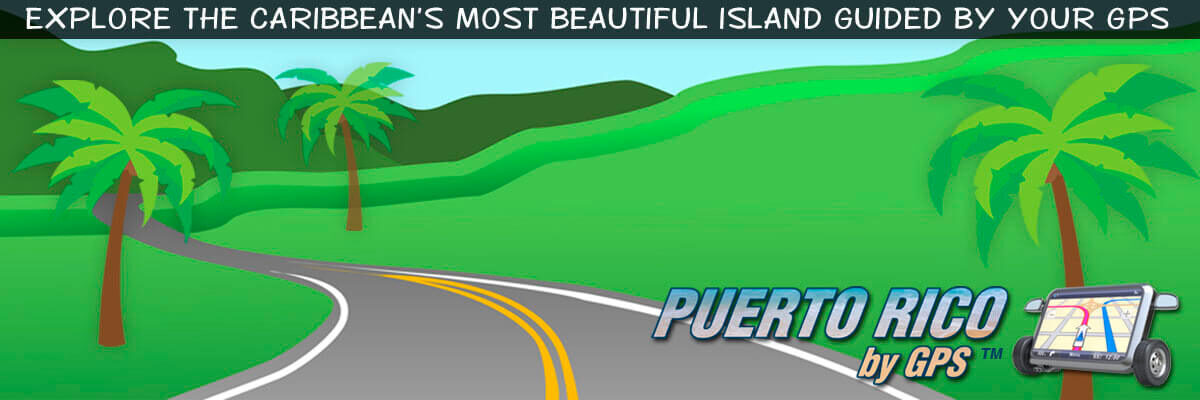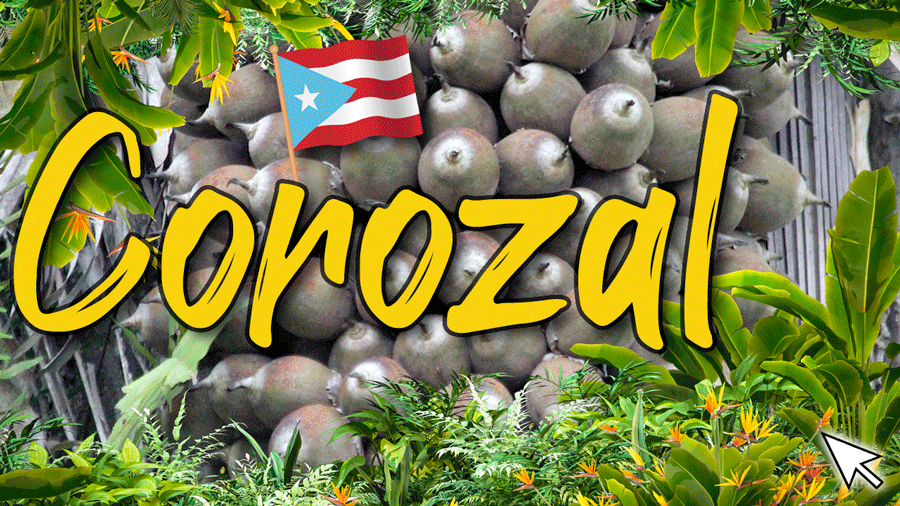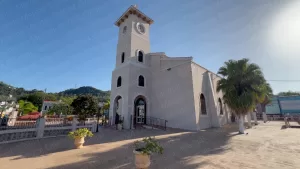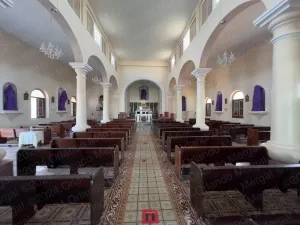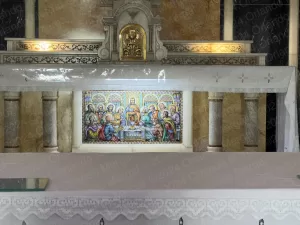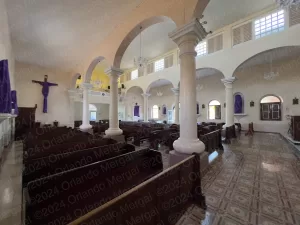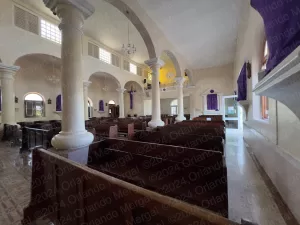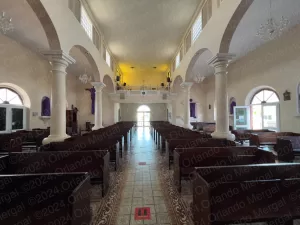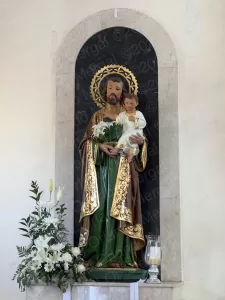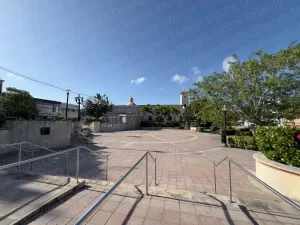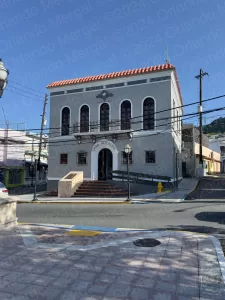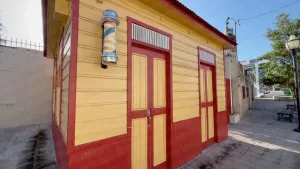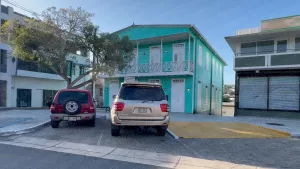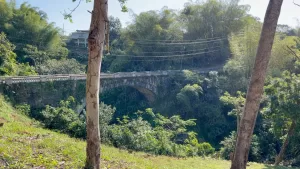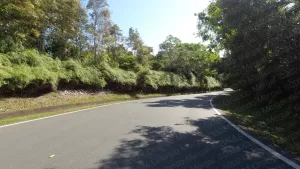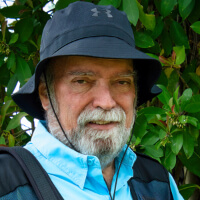The other day my wife and I visited the little town of Corozal, Puerto Rico. It’s a small town (2,601 inhabitants) that sits almost at the geographical heart of Puerto Rico (that would be Orocovis).
The drive to Corozal was easy. We took toll road PR-22 going west, got off on exit 22B towards road 165 going south, off again at exit 4 towards PR‑2 going west, took a slight right turn at PR-22 towards Corozal, drove to the very end, turned left on PR-159, right on PR-189 going west and arrived a few minutes later in the town of Corozal. The entire trip took a little over an hour.
Click on image to watch the video
When we arrived in Corozal it was 7:44am on the morning of March 19th. To our surprise, there was already a considerable amount of traffic in town. So much so that I had to drive several times around the main square before I found a parking spot.
As always, our first stop was at the lovely Sacred Family Parish. It’s as small temple with a single bell tower in the center and four clocks that don’t work facing the cardinal points. The bells do toll on the hour. I know because I heard them while I was there.
Sacred Family Parish is not a posh building in any sense of the word, but it does exude a great level of peace and elegance that stems from its simple but beautiful architecture.
At first glance we thought we had struck out, because the front and lateral gates were closed. But walking around the building we discovered a rear entrance that led to a lateral door that was open.
Many Catholic churches celebrate mass early in the morning and then close their temples during most of the day. This is because many lack the resources and the personnel to have someone watching all day long. And since robbery and vandalism have become real issues in modern times, they simply choose to close to protect the premises.
This is a sad reflection of the times we are living in. When I was a kid churches of all denominations were open round the clock. Hence, anyone who was afflicted, in sorrow or in search of illumination could simply walk into a temple at any time of the day or night, say a prayer and seek holy guidance. But not anymore.
- Sacred Family Parish interior
(click on image to see it larger)
- Sacred Family Parish interior
(click on image to see it larger)
- Sacred Family Parish interior
(click on image to see it larger)
- Sacred Family Parish interior
(click on image to see it larger)
- Sacred Family Parish interior
(click on image to see it larger)
As a child my mother did her best to raise me in the Baptist faith. Hence, I know very little about the Catholic church. When I walked into Sacred Family Parish I noticed that all the figures were covered in dark purple cloth. All but one (more on that in a minute).
There was no one there, so we walked right in and took as many pictures and video as we needed, always respecting the sanctity of the place.
As we were about to leave a couple of ladies walked in, said their prayers and sang a couple of hymns. After observing that they were done, we approached them to ask questions about the temple. They suggested that we walk over to the Parish Office and ask for the deacon in charge.
At the office we learned that Sacred Family Parish was established in 1795, the same year as the town itself. We also learned that it has undergone several restorations throughout the years due to the various hurricanes that have affected the Island.
One of the questions that I asked the deacon was what do you actually call the figures that are always present in Catholic churches. Are they effigies? Are they statues? Are they saints? Coming from the Baptist camp, that is probably the main difference between Protestant and Catholic temples. Protestant temples don’t have effigies. They only have a cross at the altar and that’s it.
Well, to my surprise, they don’t call them anything. They simply call them by their names. Case in point, there was single figure that was uncovered and the deacon referred to it as “San José” (Saint Joseph). And why was it uncovered, you might ask? Well, because it was “his” week, so he had to be visible.
The rest were covered following a centuries old tradition that establishes that they should be covered during the lent or “cuaresma” period and revealed at the beginning of Holy Week.
So there you go. Like our friends at NBC like to say: “the more you know”.
After leaving the Parish Office we went straight to Franklin Delano Roosevelt Square. It’s a beautiful square with a round sitting area that’s immediately north of Sacred Heart Parish.
Most towns in Puerto Rico follow the Roman model, that in turn was inherited from Spain. The Catholic church sits at the east end of the square and City Hall is usually on the western end. And, of course, the church altar is always on the eastern end of the buildings.
Well, in the case of Corozal the altar does point east, but the church sits at the southern end of the square and City Hall is at the northern end. Why everything was laid out that way is beyond me. After all, they were the first things built in town, so it’s not like they had land limitations of any kind. But I digress.
Franklin Delano Roosevelt Square has ample tree coverage and benches galore for people watching. It also has water fountains along the west perimeter, but they weren’t working.
As always, after exploring the square we made a quick stop at City Hall to ask about other points of interest. There we met a young man who was quite friendly and outgoing, but was mostly able to tell us about “what we couldn’t see” in town.
There’s a small “Barber’s Museum” on the west side of the square, right next to Sacred Family Parish, that used to be one of those small town barber shops. On the outside it looks great, but sadly it was closed.
On the northeast end of the square there’s another old building, painted in green, that’s known as “Casa Loydí” (or the Loydí house). At one point in time it was some sort of a museum celebrating Puerto Rican Culture, but according to our friendly employee at City Hall, nowadays it’s mostly an empty building.
And before I forget, there’s also a small monument, next to the Barber Shop Museum, dedicated to the town’s fallen military heroes.
- Barber’s Museum
(click on image to see it larger)
- Casa Loydí
(click on image to see it larger)
- Mavilla Bridge
(click on image to see it larger)
So there we were. It was a little over 8:30am and we were basically done with the town of Corozal. There were a couple of places that I wanted to explore in the rural areas, but the center of town was done.
There was a one-lane bridge that I had read about during my research called the Mavilla Bridge that dates back to 1903 and a State Park called Monte Choca. So we decided to explore those. In hindsight, we should have visited them in the reverse order, but that’s the kind of thing that you learn after the fact.
The Mavilla Bridge sits on the northeastern end of Corozal, on kilometer 17.7 of road 159. What’s interesting about this bridge is that it has retained its original design and structure for over a century. So we went there, got out of our car, went across it on foot, took some pictures and video and returned to our car.
So why did we actually go there, you might ask? After all, it’s only a bridge. Well, because it’s there. The same reason why I went to the Segovia aqueduct in Spain and walked across it… because it was there.
From the Mavilla Bridge we drove all the way to the south end of the municipality, to a place called the Monte Choca State Park. It’s not a state park in the sense that you might visualize it in the United States. It’s simply a huge piece of land that the government has reserved for conservation purposes.
When we got there we discovered three things: that the place was closed, that there weren’t any recreational facilities and that now we were at the far end of Corozal. That’s why we should have gone to Monte Choca first and to the Mavilla Bridge last.
I must add, however, that Corozal has some of the nicest countryside that I’ve seen in Puerto Rico. The place is simply gorgeous. And the view of the north coast on a clear day must be stunning.
And I do say “must be” because during our visit there was this thick haze in the atmosphere that hardly let us define the horizon. So we drove along the Monte Choca area as we found our way back along the Naranjito and Bayamón countryside. By 10:30am we were back on Toll Road 22 on our way to the San Juan Metroplex.
So what can I say about Corozal? Well, it’s a lovely town that’s great to visit on your way to somewhere else! And I’m not trying to make fun of the place. It’s just that some places are great for spending a couple of hours, but they hardly warrant a whole-day’s visit.
That’s why I titled this post “Corozal, Gateway To The Heart Of Puerto Rico”. It’s not a euphemism. It’s not click bait. It’s the truth.
Corozal is surrounded by several wonderful towns that you can combine for a day’s worth of adventure. Those towns are: Orocovis, Barranquitas and Aibonito, all to the south. There’s so much more to do in those towns that an entire day won’t suffice.
And the food? Oh my God. The mom and pop restaurants in all four towns are simply amazing. So take some time to enjoy the local cuisine.
In our case, we weren’t there for the food. My wife and I were there to do a job; to collect the information, the photos and the footage to produce our blog post and video. So we were back home in San Juan before noon.
And talking about San Juan, if you’re planning to visit the Old City, save yourself the hassle of traditional city tours. They’re expensive and you’ll be herded along with people that won’t necessarily share your interests.
Instead, order The Old San Juan Walking Tour. It’s packed with useful information about all the main attractions, as well as every GPS coordinate and two hours of exclusive online video. That way you’ll be able to —visit before you visit— and hit the ground running when you arrive in the Old City.
See you next time!
©2024,Orlando Mergal, MA
____________________
Bilingual Content Creator, Blogger, Podcaster,
Author, Photographer and New Media Expert
Tel. 787–750-0000, Mobile 787–306-1590
